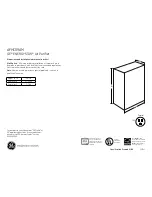
II - 14
Processes and Functions
SM830063
2
(1)
Drain pump control turns ON when the compressor is activated in cooling operation.
(2)
When the compressor turns OFF due to freeze prevention control, drain pump turns ON for 20 minutes.
(3)
Drain pump control turns ON when the floating switch is activated. If the operation is performed for 5 minutes and
the floating switch does not return to the original position, an alarm message P10 is displayed. (Operation contin-
ues.)
If the floating switch returns to the original position, control turns OFF 5 minutes after the return of the floating
switch.
16. Indoor Electronic Control Valve
¶
However, when the compressor is stopped, there still occur 20 pulses. When the power is first switched on until the
ON / OFF operation button is pressed, the valve is open at 480 pulses.
¶
From then on, control is accomplished as shown below.
16-1. Cooling and dehumidifying operation
(1)
When operation is stopped and thermo-off, operation is still at 20 pulses. However, the electronic control valve may
be opened for about 3 minutes to recover oil in the pipes.
(2)
When the thermostat is active, the valve is controlled in the range of 70 to 480 pulses.
(3)
When the compressor maximum discharge temperature
]
98 ˚C, the degree of electronic control valve opening
increases.
(4)
When the super-heat of indoor unit (E3 temperature – E1 temperature) is low, the degree of electronic control valve
opening is reduced. However, (3) has priority.
(5)
When the super-heat at the indoor unit outlet is high, the degree of the electronic control valve opening increases.
16-2. Heating operation
(1)
When operation is stopped and the thermostat is inactive, the electronic expansion valve opens and closes so that
the refrigerant does not accumulate excessively in the indoor unit.
(2)
When thermo-on, the valve is controlled within the range of 70 to 480 pulses.
(3)
When the compressor maximum discharge temperature
]
98 ˚C, the degree of electronic control valve opening.
(4)
When the degree of heat at the outdoor heat exchanger (coil temperature – liquid temperature) is high, the degree
of electronic control valve opening increases.
(5)
When the sub-cool of indoor unit (E2 temperature – E1 temperature) is low, the degree of electronic expansion
valve opening reduces. However, (4) above takes precedence.
(6)
When the degree of overcooling at the indoor unit outlet (E2 temperature – E1 temperature) is high, the degree of
electronic expansion valve opening is increased.
(7)
When the indoor heat exchanger temperature
[
30 ˚C, the electronic control valve returns to its initial pulse control.
15. Drain Pump Control (Does not include K, T, D, F, FM Type)
















































